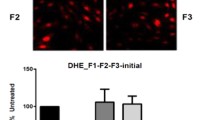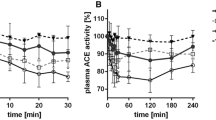Abstract
The purpose of the present work consisted in the production of egg white hydrolysates with multiple biological activities that would allow the control of some pathologies related to the metabolic syndrome. Eight food-grade enzymes from different sources and specificities were used, and the hydrolysates were analysed for in vitro antioxidant, anti-inflammatory, bile acid-binding, angiotensin I-converting enzyme (ACE)-inhibitory and dipeptidyl peptidase IV-inhibitory activities. The hydrolysate of egg white with Bc Pepsin for 8 h presented a high ACE-inhibitory activity with an IC50 equivalent to, approximately, 50 µg protein/mL, as well as important peroxyl radical-scavenging and bile acid-binding capacities. The hydrolysate with Peptidase 433P for 24 h stood out for its peroxyl radical-scavenging capacity, equivalent to 900–1100 μmol Trolox/g of protein, and its potential hypocholesterolaemic activity. Both hydrolysates also exhibited a moderate DDP IV-inhibitory activity and prevented oxidative damage in RAW 264.7 macrophages, while that with Peptidase 433P also inhibited the release of proinflammatory cytokines induced by LPS in this cell line, in particular, that of IL-6. The multiple properties exerted by these hydrolysates suggest that they could target several symptoms of a complex disease, such as the metabolic syndrome.


Similar content being viewed by others
References
Akalin AS (2014) Dairy-derived antimicrobial peptides: action mechanisms, pharmaceutical uses and production proposals. Trends Food Sci Technol 36:79–95
Hernández-Ledesma B, Hiesh CC, de Lumen BO (2009) Antioxidant and anti-inflammatory properties of cancer preventive peptide lunasin in RAW 264.7 macrophages. Biochem Biophys Res Commun 390:803–808
Pihlanto A (2006) Antioxidative peptides derived from milk proteins. Int Dairy J 16:1306–1314
Martínez-Maqueda D, Miralles B, Recio I, Hernández-Ledesma B (2012) Antihypertensive peptides from food proteins: a review. Food Funct 3:350–361
Wada Y, Lönnerdal B (2014) Bioactive peptides derived from human milk proteins-mechanisms of action. J Nutr Biochem 25:503
Otani L, Ninomiya T, Murakami M, Osajima K, Kato H, Murakami T (2009) Sardine peptide with angiotensin I-converting enzyme inhibitory activity improves glucose tolerance in stroke-prone spontaneously hypertensive rats. Biosci Biotech Bioch 73:2203–2209
Correa APF, Daroit DJ, Coelho J, Meira SM, Lopes FC, Segalin J, Risso PH, Brandelli A (2011) Antioxidant, antihypertensive and antimicrobial properties of ovine milk caseinate hydrolyzed with a microbial protease. J Sci Food Agric 91:2247–2254
Fujita H, Sasaki R, Yoshikawa M (1995) Potentiation of the antihypertensive activity of orally administered ovokinin, a vasorelaxing peptide derived from ovalbumin, by emulsification in egg phosphatidylcholine. Biosci Biotechnol Biochem 59:2344–2345
Miguel M, Recio I, Gómez-Ruiz JA, Ramos M, López-Fandiño R (2004) Angiotensin I-converting enzyme inhibitory activity of peptides derived from egg white proteins by enzymatic hydrolysis. J Food Prot 67:1914–1920
Miguel M, Manso M, Aleixandre A, Alonso MJ, Salaices M, López-Fandiño R (2007) Vascular effects, angiotensin I-converting enzyme (ACE)-inhibitory activity, and antihypertensive properties of peptides derived from egg White. J Agric Food Chem 55:10615–10621
Miguel M, Manso MA, Martín-Álvarez P, Aleixandre A, López-Fandiño R (2007) Angiotensin-converting enzyme activity in plasma and tissues of spontaneously hypertensive rats after the short- and long-term intake of hydrolysed egg white. Mol Nutr Food Res 51:555–563
García-Redondo AB, Roque FR, Miguel M, López-Fandiño R, Salaices M (2010) Vascular effects of egg white-derived peptides in resistance arteries from rats. Structure-activity relationships. J Sci Food Agric 90:1988–1993
Dávalos A, Miguel M, Bartolomé B, López-Fandiño R (2004) Antioxidant activity of peptides derived from egg white proteins by enzymatic hydrolysis. J Food Prot 67:1939–1944
Manso MA, Miguel M, Even J, Hernández R, Aleixandre A, López-Fandiño R (2008) Effect of the long-term intake of an egg white hydrolysate on the oxidative status and blood lipid profile of spontaneously hypertensive rats. Food Chem 109:361–367
Huang W, Chakrabarti S, Majumder K, Jiang Y, Davidge ST, Wu J (2010) Egg-derived peptide IRW inhibits TNF-α induced inflammatory response and oxidative stress in endothelial cells. J Agric Food Chem 58:10840–10846
You SJ, Udenigwe CC, Aluko RE, Wu J (2010) Multifunctional peptides from egg white lysozyme. Food Res Int 43:848–855
Majumder K, Chakrabarti S, Morton JS, Panahi S, Kaufman S, Davidge ST, Wu JP (2013) Egg-derived tri-peptide IRW exerts antihypertensive effects in spontaneously hypertensive rats. PLoS ONE 8:e82829
Yu Z, Yin Y, Zhao W, Yu Y, Liu B, Liu J, Chen F (2011) Novel peptides derived from egg white protein inhibiting alpha-glucosidase. Food Chem 129:1376–1382
Lacroix IME, Li-Chan ECY (2012) Dipeptidyl peptidase-IV inhibitory activity of dairy protein hydrolysates. Int Dairy J 25:97–102
Alberti KG, Zimmet P, Shaw J (2006) Metabolic syndrome-A new world-wide definition. A consensus statement from the international diabetes federation. Diabet Med 23:469–480
Sentandreu MA, Toldrá F (2006) A fluorescence-based protocol for quantifying angiotensin-converting enzyme activity. Nat Protoc 1:2423–2427
Quirós A, Contreras MD, Ramos M, Amigo L, Recio I (2009) Stability to gastrointestinal enzymes and structure-activity relationship of beta-casein-peptides with antihypertensive properties. Peptides 30:1848–1853
Ou BX, Hampsch-Woodill M, Prior RL (2001) Development and validation of an improved oxygen radical absorbance capacity assay using fluorescein as the fluorescent probe. J Agric Food Chem 49:4619–4626
Yoshie-Stark Y, Wasche A (2004) In vitro binding of bile acids by lupin protein isolates and their hydrolysates. Food Chem 88:179–184
Van der Plancken I, Van Remoortere M, Van Loey A, Hendrickx ME (2004) Trypsin inhibition activity of heat-denatured ovomucoid: a kinetic study. Biotechnol Prog 20:82–86
Miguel M, López-Fandiño R, Ramos M, Aleixandre A (2005) Short-term effect of egg-white hydrolysate products on the arterial blood pressure of hypertensive rats. Br J Nutr 94:731–737
Miguel M, Álvarez Y, López-Fandiño R, Alonso MJ, Salaices M (2007) Vasodilator effects of peptides derived from egg white proteins. Regul Pept 140:131–135
Freeman BD, Natanson C (2000) Anti-inflammatory therapies and sepsis and septic shock. Expert Opin Investig Drugs 9:1651–1663
Howard A, Udenigwe CC (2013) Mechanisms and prospects of food protein hydrolysates and peptide-induced hypolipidaemia. Food Funct 4:40–51
Conway V, Gauthier SF, Pouliot Y (2013) Antioxidant activities of buttermilk proteins, whey proteins, and their enzymatic hydrolysates. J Agric Food Chem 16:364–372
Quiñones M, Sánchez D, Muguerza B, Moulay L, Laghi S, Miguel M, Aleixandre A (2010) Long-term intake of CocoanOX attenuates the development of hypertension in spontaneously hypertensive rats. Food Chem 122:1013–1019
Samaranayaka AGP, Li-Chan ECY (2011) Food-derived peptidic antioxidants: a review of their production, assessment, and potential applications. J Funct Foods 3:229–254
Porez G, Prawitt J, Gross B, Staels B (2012) Bile acid receptors as targets for the treatment of dyslipidemia and cardiovascular disease. J Lipid Res 53:1723–1737
Lacroix IME, Li-Chan ECY (2012) Dipeptidyl peptidase-IV inhibitory activity of dairy protein hydrolysates. Int Dairy J 25:97–102
Silveira ST, Martínez-Maqueda D, Recio I, Hernández-Ledesma B (2013) Dipeptidyl peptidase-IV inhibitory peptides generated by tryptic hydrolysis of a whey protein concentrate rich in β-lactoglobulin. Food Chem 141:1072–1077
Pieter BJW (2006) Protein hydrolysate enriched in peptides inhibiting DPP-IV and their use. WO 2006/068480 200
Acknowledgments
This study has received financial support from the Project AGL2012-32387 from MINECO. M. G.-R. acknowledges the financial support of MICINN through a FPI Grant and I. L.-E. that of CSIC through a JAE-Doc Grant.
Author information
Authors and Affiliations
Corresponding author
Ethics declarations
Conflict of interest
None.
Compliance with Ethics Requirements
This article does not contain any studies with human or animal subjects.
Rights and permissions
About this article
Cite this article
Garcés-Rimón, M., López-Expósito, I., López-Fandiño, R. et al. Egg white hydrolysates with in vitro biological multiactivities to control complications associated with the metabolic syndrome. Eur Food Res Technol 242, 61–69 (2016). https://doi.org/10.1007/s00217-015-2518-7
Received:
Revised:
Accepted:
Published:
Issue Date:
DOI: https://doi.org/10.1007/s00217-015-2518-7




